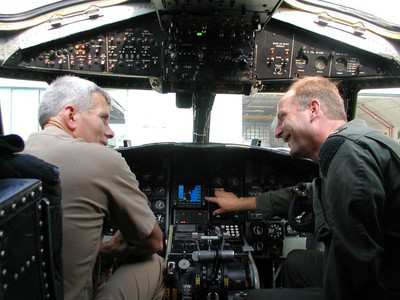Wed, May 26, 2004
E-2 Program Prototypes Applying Lessons Learned In Recent
Conflicts
The Naval Air Systems Command has successfully prototyped a
commercial navigation system currently installed in two of the US
Navy’s E-2C Hawkeye aircraft. The GNS-530, originally
produced for commercial aviation applications by Garmin
International of Olathe, Kansas, will bring dual utility to the
Hawkeye cockpit by simultaneously satisfying Communication,
Navigation and Surveillance/Air Traffic Management (CNS/ATM)
enhanced display requirements while also providing precision
approach to the E-2C Fleet.

The possibility of incorporating the GNS-530 navigation system
into the E-2C was explored following a NAVAIR analysis of
alternatives to identify a system that could provide precision
approach capability to the E-2C fleet quickly and cost effectively
and address lessons learned during Operations Enduring Freedom and
Iraqi Freedom.
Two aircraft were prototyped with the system. The first, based
in Atlanta (GA) with the Night Wolves of Carrier Airborne Early
Warning Squadron Seventy Seven (VAW-77), one of two E-2 Reserve
squadrons, demonstrated that the GNS-530 could be successfully
installed quickly and cost efficiently. The second prototype,
representative of Group II aircraft in the Fleet, was based in
Norfolk (VA) with the Greyhawks of Carrier Airborne Early Warning
Squadron One Hundred Twenty (VAW-120). This aircraft was selected
for Carrier Suitability tests with the system at NAS Patuxent
River, where testing verified its ability to withstand the rigors
of operating in a carrier environment. These two proof-of-concept
demonstrations proved so successful that both prototyped aircraft
are presently utilizing the system.

Additional test events at Patuxent River are planned this summer
with the Hawkeye 2000 variant of the aircraft, which will be
focusing on IFR certification and Electromagnetic Compatibility
(EMC). Fleet installations of the GNS-530 in E-2C Hawkeye aircraft
are anticipated to begin in 2005.
More News
Airport Marking Aids Markings used on runway and taxiway surfaces to identify a specific runway, a runway threshold, a centerline, a hold line, etc. A runway should be marked in ac>[...]
"It is extremely difficult, if not impossible, for manned aircraft to see a drone while conducting crop-enhancing and other aerial applications at low altitudes and high speeds. We>[...]
Aero Linx: The Skyhawk Association The Skyhawk Association is a non-profit organization founded by former Skyhawk Pilots which is open to anyone with an affinity for the A-4 Skyhaw>[...]
“The T-54A benefits from an active Beechcraft King Air assembly line in Wichita, Kansas, where all required METS avionics and interior modifications are installed on the line>[...]
Aero Linx: Aerostar Owners Association The Association offers the Aerostar Owner a unique opportunity to tap an invaluable source of information concerning the care and feeding of >[...]
 ANN's Daily Aero-Term (04.28.24): Airport Marking Aids
ANN's Daily Aero-Term (04.28.24): Airport Marking Aids Aero-News: Quote of the Day (04.28.24)
Aero-News: Quote of the Day (04.28.24) ANN's Daily Aero-Linx (04.28.24)
ANN's Daily Aero-Linx (04.28.24) Aero-News: Quote of the Day (04.29.24)
Aero-News: Quote of the Day (04.29.24) ANN's Daily Aero-Linx (04.29.24)
ANN's Daily Aero-Linx (04.29.24)




